The Effect of Polymer Elastic Particles Modified with Nano-Silica on the Mechanical Properties of Oil Well Cement-Based Composite Materials
Abstract
:1. Introduction
2. Experiment
2.1. Experimental Materials
2.2. Experimental Methods
2.2.1. Polymer Particle Modification Methods
2.2.2. Analysis Method of the Modified Polymer Particles
2.2.3. Preparation of Cement Slurry
2.2.4. Evaluation of Mechanical Properties of Cement Sample
2.2.5. Microstructure of Cement Sample
3. Results and Discussion
3.1. Characterization and Performance of Modified Polymer Particles
3.1.1. Infrared Spectroscopy
3.1.2. Thermogravimetric Analysis
3.1.3. Surface Contact Angle Analysis
3.1.4. Comparison of the Compressive Strength of Oil Well Cement Slurry before and after Modification
3.2. Mechanical Properties of Modified Flexible Particle Cement Sample
3.2.1. Stress–strain Behavior of Cement Paste
3.2.2. Impact Strength of Cement Paste
3.3. Microstructure of Modified Polymer Particle Oil Well Cement
3.3.1. Scanning Electron Microscopy
3.3.2. CT Scanning of Simulated Perforated Specimens
4. Conclusions
Author Contributions
Funding
Institutional Review Board Statement
Data Availability Statement
Conflicts of Interest
References
- Ezeuko, C.C.; Gates, I.D. Thermal oil recovery from fractured reservoirs: Energy and emissions intensities. Energy 2018, 155, 29–34. [Google Scholar] [CrossRef]
- Kurnia, J.C.; Shatri, M.S.; Putra, Z.A.; Zaini, J.; Caesarendra, W.; Sasmito, A.P. Geothermal energy extraction using abandoned oil and gas wells: Techno-economic and policy review. Int. J. Energy Res. 2022, 46, 28–60. [Google Scholar] [CrossRef]
- Suppachoknirun, T.; Tutuncu, A.N. Hydraulic fracturing and production optimization in eagle ford shale using coupled geomechanics and fluid flow model. Rock Mech. Rock Eng. 2017, 50, 3361–3378. [Google Scholar] [CrossRef]
- Arjomand, E.; Bennett, T.; Nguyen, G.D. Evaluation of cement sheath integrity subject to enhanced pressure! J. Pet. Sci. Eng. 2018, 170, 1–13. [Google Scholar] [CrossRef]
- Li, J.; Su, D.; Tang, S.; Li, Z.; Wu, H.; Huang, S.; Sun, J. Deformation and damage of cement sheath in gas storage wells under cyclic loading. Energy Sci. Eng. 2021, 9, 483–501. [Google Scholar] [CrossRef]
- De Andrade, J.; Sangesland, S. Cement Sheath Failure Mechanisms: Numerical Estimates to Design for Long-Term Well Integrity. J. Pet. Sci. Eng. 2016, 147, 682–698. [Google Scholar] [CrossRef]
- Fan, M.; Li, J.; Liu, G. Study on the sealing integrity of cement sheath during volume fracturing of shale gas of horizontal well. Clust. Comput. 2019, 22, S5009–S5016. [Google Scholar] [CrossRef]
- Patel, H.; Salehi, S. Structural integrity of liner cement in oil and gas wells: Parametric study, sensitivity analysis, and risk assessment. Eng. Fail. Anal. 2021, 122, 105203. [Google Scholar] [CrossRef]
- Irie, M.; Okada, M.; Maruo, Y.; Nishigawa, G.; Matsumoto, T. Shear bond strength of resin luting materials to lithium disilicate ceramic: Correlation between flexural strength and modulus of elasticity. Polymers 2023, 15, 1128. [Google Scholar] [CrossRef] [PubMed]
- Su, D.; Huang, S.; Li, Z.; Li, J.; Xiao, D.; Wang, Z.; Li, J.; Ni, S. Mechanical property design method of cement sheath in a horizontal shale oil well under fracturing conditions. Pet. Explor. Dev. 2022, 49, 919–928. [Google Scholar] [CrossRef]
- Song, J.; Xu, M.; Tan, C.; You, F.; Wang, X.; Zhou, S. Study on an Epoxy Resin System Used to Improve the Elasticity of Oil-Well Cement-Based Composites. Materials 2022, 15, 5258. [Google Scholar] [CrossRef]
- Contreras, E.Q.; Althaus, S.M. Design of aromatic polyamides to modify cement performance under triaxial cyclic tests. Mrs Commun. 2021, 11, 777–782. [Google Scholar] [CrossRef]
- Zhang, R.; Wang, H.; Ji, J.; Suo, Z.; Ou, Z. Influences of different modification methods on surface activation of waste tire rubber powder applied in cement-based materials. Constr. Build. Mater. 2022, 314, 125191. [Google Scholar] [CrossRef]
- Hu, P.; Guo, W.; Wei, L. Applicability Study on Modified argillaceous slate as subgrade filling for high-speed railway. Appl. Sci. 2022, 12, 2227. [Google Scholar] [CrossRef]
- Barua, R.; Daly-Seiler, C.S.; Chenreghanianzabi, Y.; Markel, D.; Li, Y.; Zhou, M.; Ren, W. Comparing the physicochemical properties of dicalcium phosphate dihydrate (DCPD) and polymeric DCPD (P-DCPD) cement particles. J. Biomed. Mater. Res. Part B Appl. Biomater. 2021, 109, 1644–1655. [Google Scholar] [CrossRef] [PubMed]
- Cheng, X.; Huang, S.; Long, D.; Li, Z.; Guo, X. Improvement of the properties of plasma-modified ground tire rubber filled cement paste. Acta Pet. Sin. 2014, 35, 371–376. [Google Scholar] [CrossRef]
- He, L.; Ma, Y.; Liu, Q.; Mu, Y. Surface modification of crumb rubber and its influence on the mechanical properties of rubber-cement concrete. Constr. Build. Mater. 2016, 120, 403–407. [Google Scholar] [CrossRef]
- Zhong, D.; Wang, S.; Gao, Y.; Wang, L.; Wang, J. Influence of rubber powder modification methods on the mechanical and durability properties of rubberized magnesium oxychloride cement. Crystals 2021, 11, 1323. [Google Scholar] [CrossRef]
- Li, Y.; Zhang, X.; Wang, R.; Lei, Y. Performance enhancement of rubberised concrete via surface modification of rubber: A review. Constr. Build. Mater. 2019, 227, 116691. [Google Scholar] [CrossRef]
- Liu, K.; Cheng, X.; Zhang, X.; Guo, X.; Zhuang, J. Design of low-density cement optimized by cellulose-based fibre for oil and natural gas wells. Powder Technol. 2018, 338, 506–518. [Google Scholar] [CrossRef]
- Liu, H.; Jin, J.; Yu, Y.; Liu, H.; Liu, S.; Shen, J.; Xia, X.; Ji, H. Influence of halloysite nanotube on hydration products and mechanical properties of oil well cement slurries with nano-silica. Constr. Build. Mater. 2020, 247, 118545. [Google Scholar] [CrossRef]
- Song, J.; Xu, M.; Liu, W.; Wang, X.; Xu, P.; Huang, F.; Pan, Y. Thermoplastic rubber (TPR) modified by a silane coupling agent and its influence on the mechanical properties of oil well cement paste. Adv. Mater. Sci. Eng. 2019, 2019, 3587081. [Google Scholar] [CrossRef] [Green Version]
- Yang, Y.; Yuan, B.; Sun, Q.; Tang, X.; Xie, Y. Mechanical properties of EVA-modified cement for underground gas storage. J. Nat. Gas Sci. Eng. 2015, 27, 1846–1851. [Google Scholar] [CrossRef]
- Cheng, X.; Chen, H.; Huang, S.; Li, Z.; Guo, X. Improvement of the properties of plasma-modified ground tire rubber-filled cement paste. J. Appl. Polym. Sci. 2012, 126, 1837–1843. [Google Scholar] [CrossRef]
- Sugiman, S.; Salman, S.; Maryudi, M. Effects of volume fraction on water uptake and tensile properties of epoxy filled with inorganic fillers having different reactivity to water. Mater. Today Commun. 2020, 24, 101360. [Google Scholar] [CrossRef]
- Li, J.; Chen, P.; Cai, H.; Xu, Y.; Tian, X.; Li, C.; Cui, L. Performance of rubber mortars containing silica coated rubber. Mater. De Construcción 2021, 71, e244. [Google Scholar] [CrossRef]
- Santos, L.; Taleghani, A.D.; Li, G. Nanosilica-treated shape memory polymer fibers to strengthen wellbore cement. J. Pet. Sci. Eng. 2020, 196, 107646. [Google Scholar] [CrossRef]
- Lee, S.-J.; Kawashima, S.; Woo, S.K.; Won, J.P. Interfacial properties of nanosilica-treated structural polymer fibres in cement matrix composites. Compos. Struct. 2018, 202, 465–472. [Google Scholar] [CrossRef]
- Behnia, B.; Safardoust-Hojaghan, H.; Amiri, O.; Salavati-Niasari, M.; Anvari, A.A. High-performance cement mortars -based composites with colloidal nano-silica: Synthesis, characterization and mechanical properties. Arab. J. Chem. 2021, 14, 103338. [Google Scholar] [CrossRef]
- El-Feky, M.S.; Mohsen, A.; El-Tair, M.; Kohail, M. Microstructural investigation for micro- nano-silica engineered magnesium oxychloride cement. Constr. Build. Mater. 2022, 342, 127976. [Google Scholar] [CrossRef]
- Rostami, M.R.; Abbassi-Sourki, F.; Bouhendi, H. Synergistic effect of branched polymer/nano silica on the microstructures of cement paste and their rheological behaviors. Constr. Build. Mater. 2019, 201, 159–170. [Google Scholar] [CrossRef]
- Chaiyaput, S.; Arwaedo, N.; Kingnoi, N.; Nghia-Nguyen, T.; Ayawanna, J. Effect of curing conditions on the strength of soil cement. Case Stud. Constr. Mater. 2022, 16, e01082. [Google Scholar] [CrossRef]
- Cheng, Q.; Zhang, J.; Zhou, N.; Guo, Y.; Pan, S. Experimental Study on Unconfined Compression Strength of Polypropylene Fiber Reinforced Composite Cemented Clay. Crystals 2020, 10, 247. [Google Scholar] [CrossRef] [Green Version]
- Barisic, I.; Dimter, S.; Rukavina, T. Elastic properties of cement-stabilised mixes with steel slag. Int. J. Pavement Eng. 2016, 17, 753–762. [Google Scholar] [CrossRef]
- Liu, H.; Bu, Y.; Nazari, A.; Sanjayan, J.G.; Shen, Z. Low elastic modulus and expansive well cement system: The application of gypsum microsphere. Constr. Build. Mater. 2016, 106, 27–34. [Google Scholar] [CrossRef]
- Patel, H.A.; Johnson, K.D.; Martinez, R.F.; Boul, P.J. Cross-linked polyrotaxane to improve mechanical properties of oil well cement. Mrs Commun. 2021, 11, 762–769. [Google Scholar] [CrossRef]
- Xu, Z.; Bao, S.; Guo, L.; Mo, H.; Wang, D.; Zhao, J. Experiment Investigation on Dynamic Failure Characteristics of Water-Saturated Frozen Cement Mortar with Transfixion Joint under Confining Pressure. Appl. Sci. 2022, 12, 4396. [Google Scholar] [CrossRef]
- Curosu, I.; Mechtcherine, V.; Vo, D.M.P.; Sennewald, C.; Cherif, C.; Woelfel, E.; Scheffler, C.; Gong, T.; Heravi, A.A.; Tamsen, E.; et al. Mineral-bonded composites for enhanced structural impact safety: Material level investigations. Beton- Stahlbetonbau 2021, 116, 45–57. [Google Scholar] [CrossRef]
- Yan, K.; Sun, H.; Gao, F.; Ge, D.; You, L. Assessment and mechanism analysis of municipal solid waste incineration bottom ash as aggregate in cement stabilized macadam. J. Clean. Prod. 2020, 244, 118750. [Google Scholar] [CrossRef]
- Zhang, S.; Fang, Z.; Qi, W.; Fan, Y.; Shah, S.P.P. Study on the Relationship between Early Shrinkage Cracking and Mechanical Properties of Nano-Clay Cement Mortar Based on Fractal Theory. Buildings 2023, 13, 123. [Google Scholar] [CrossRef]
- Yang, H.; Liu, M.; Bian, H.; Wu, L.; Liu, J.; Wang, W. The influence of SAP particle size and extra water on the dynamic mechanical behavior of SAP-modified cement-based composites. Constr. Build. Mater. 2022, 347, 128622. [Google Scholar] [CrossRef]
- Oh, S.-R.; Choi, Y.W.; Kim, Y.J. Effect of cement powder based self-healing solid capsule on the quality of mortar. Constr. Build. Mater. 2019, 214, 574–580. [Google Scholar] [CrossRef]
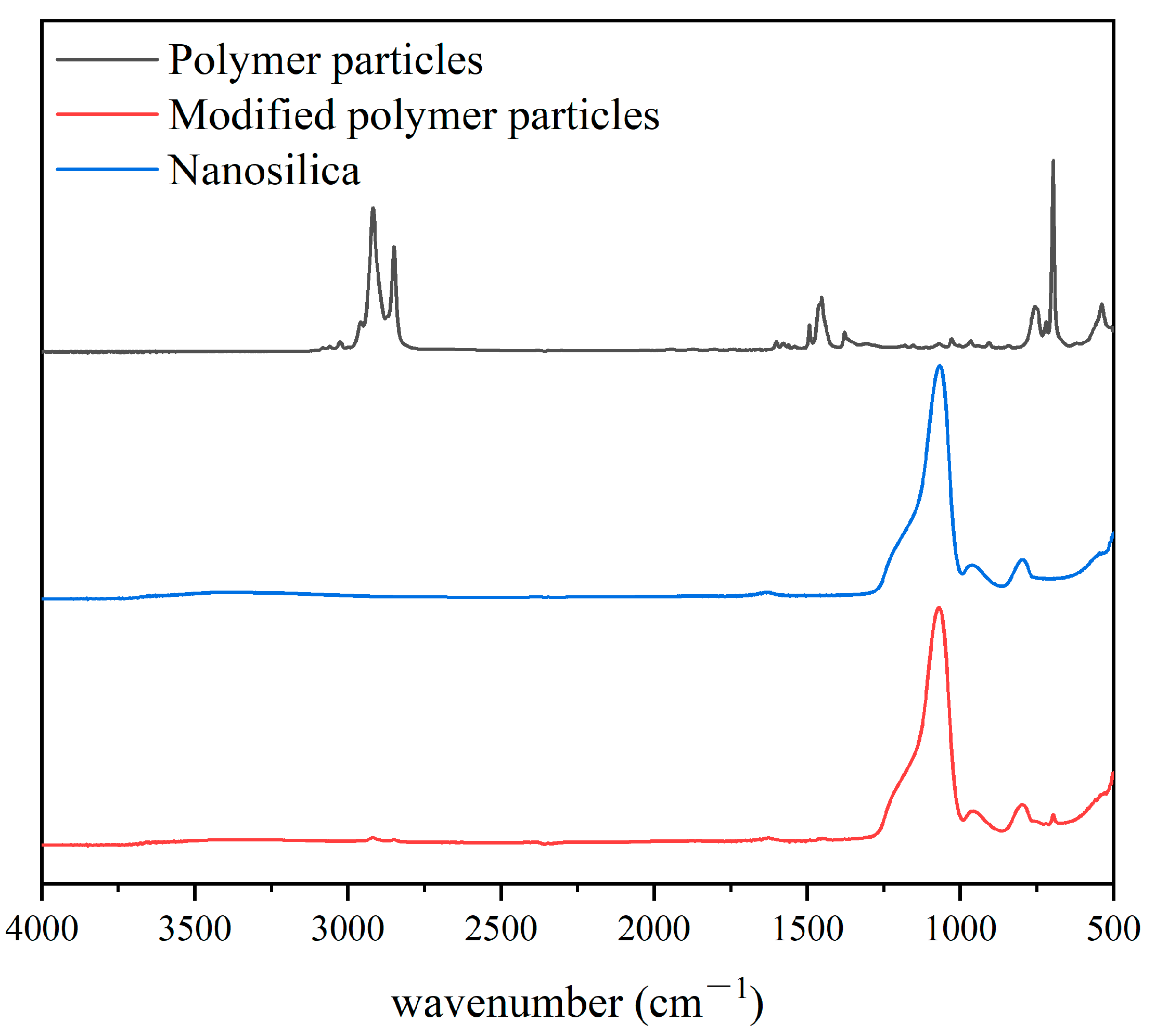
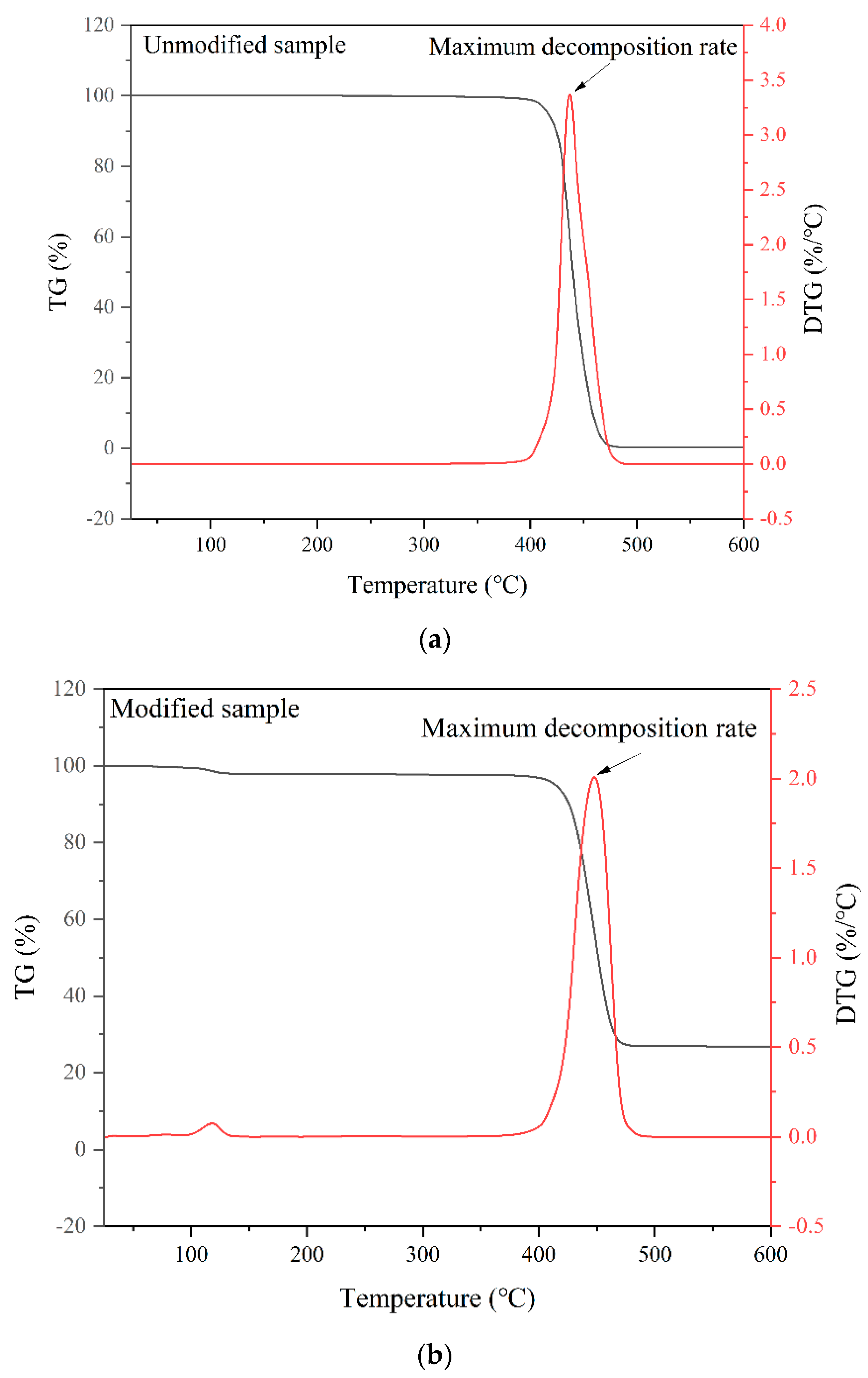
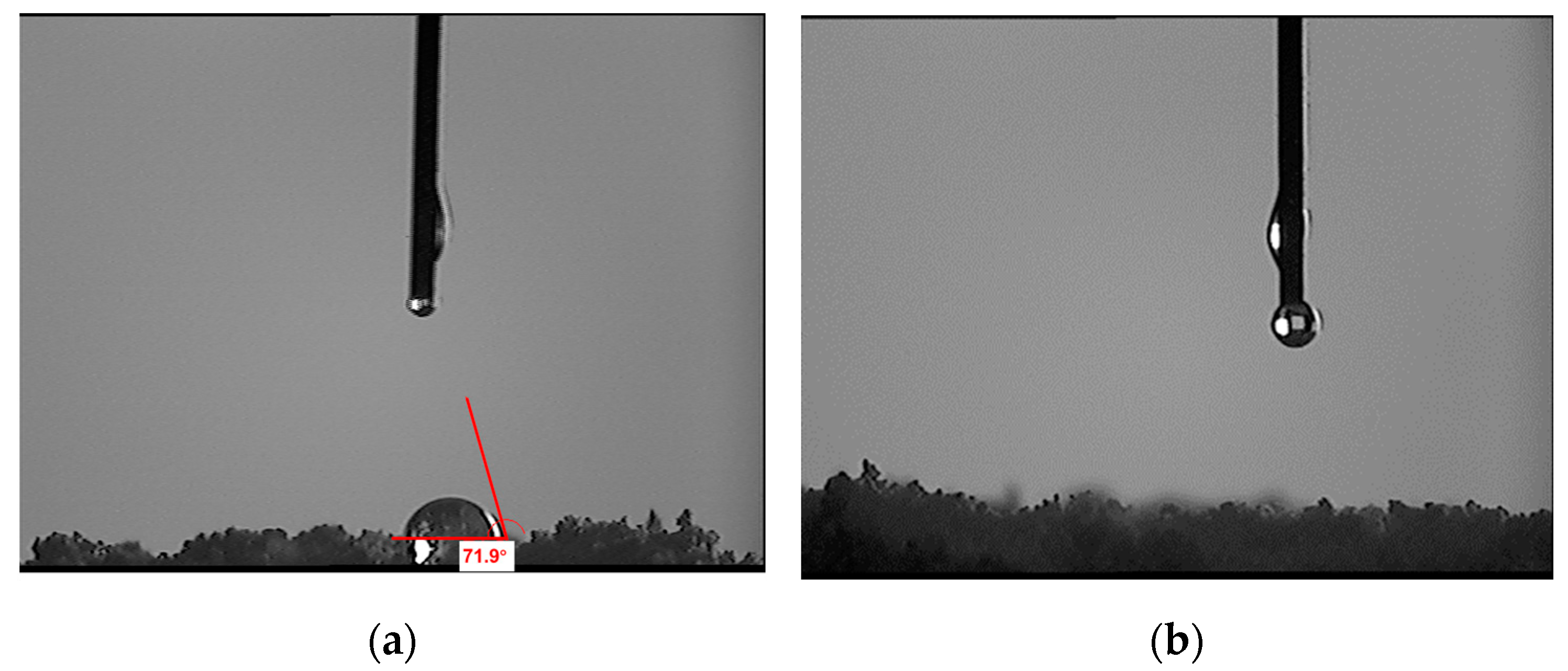


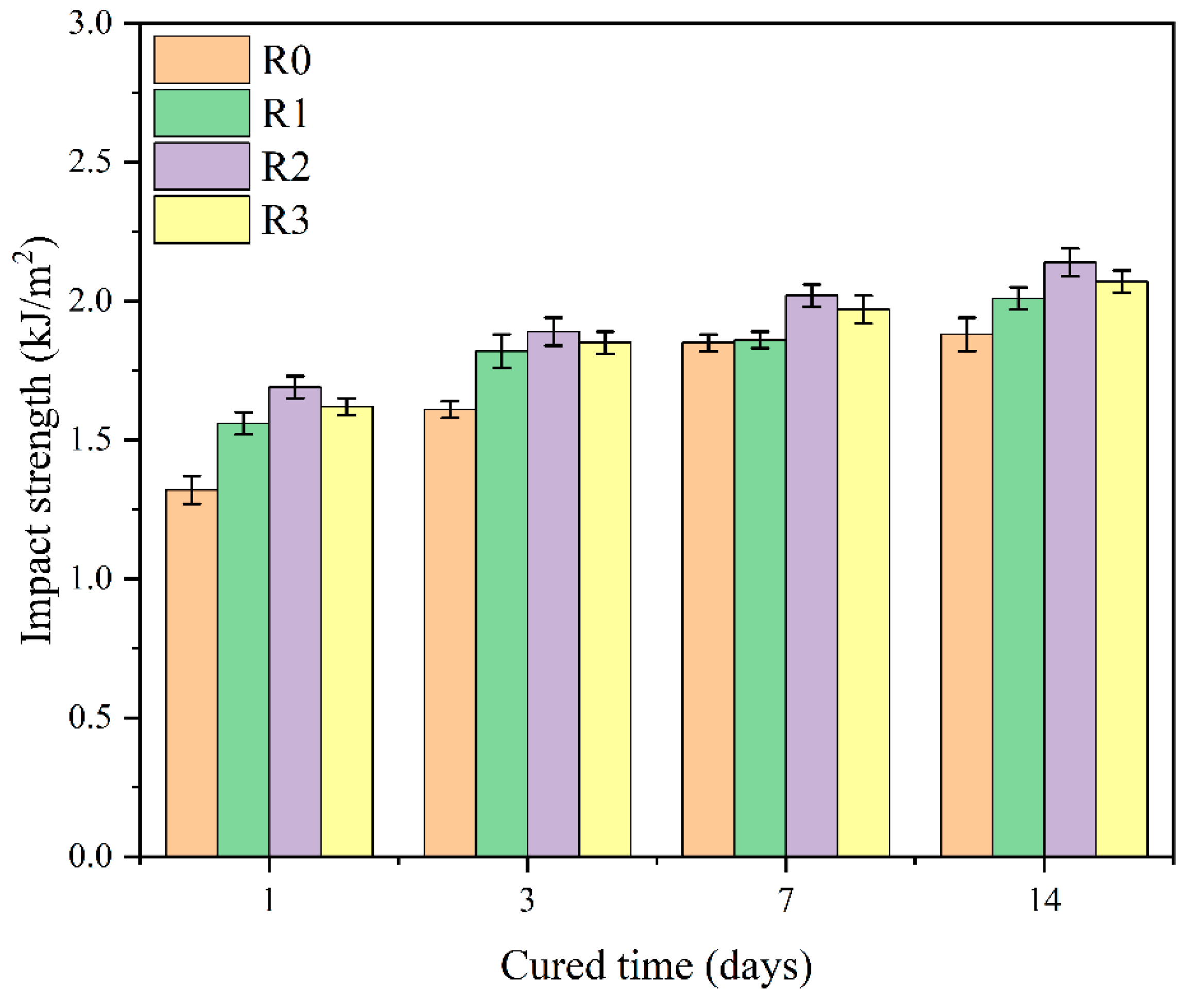

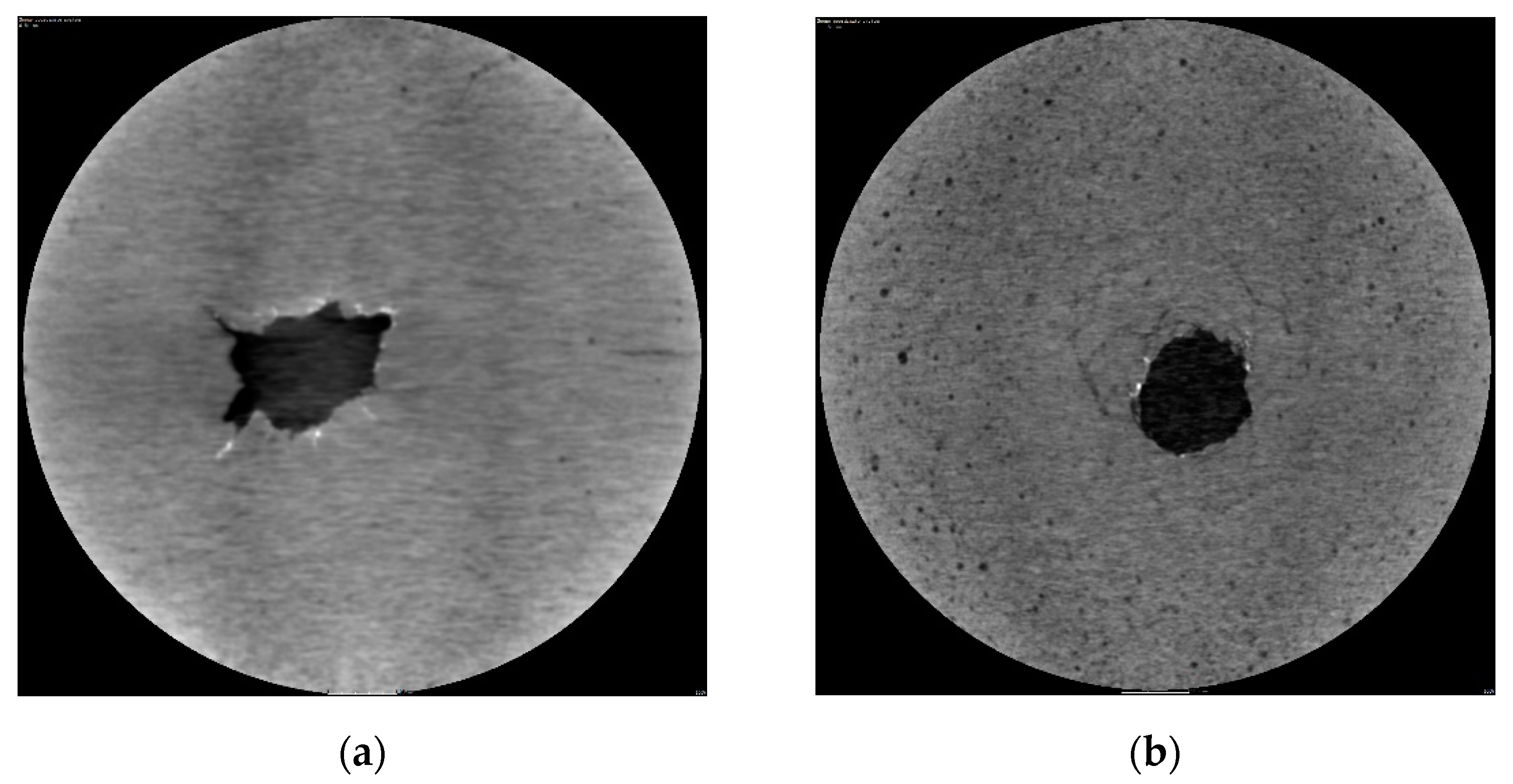
| Sample Number | Cement | Water | Filtrate Reducer | Dispersant | Retarder | Modified Polymer Particles |
|---|---|---|---|---|---|---|
| R0 | 100 | 44 | 2 | 0.8 | 0.4 | 0 |
| R1 | 100 | 44 | 2 | 0.8 | 0.4 | 3 |
| R2 | 100 | 44 | 2 | 0.8 | 0.4 | 6 |
| R3 | 100 | 44 | 2 | 0.8 | 0.4 | 9 |
| Sample Number | Compressive Strength (MPa) | Maximum Strain (%) | Elastic Modulus (GPa) |
|---|---|---|---|
| R0 | 49.6 | 0.47 | 10.6 |
| R1 | 45.3 | 0.67 | 7.8 |
| R2 | 43.5 | 1.01 | 5.3 |
| R3 | 38.7 | 1.19 | 4.1 |
Disclaimer/Publisher’s Note: The statements, opinions and data contained in all publications are solely those of the individual author(s) and contributor(s) and not of MDPI and/or the editor(s). MDPI and/or the editor(s) disclaim responsibility for any injury to people or property resulting from any ideas, methods, instructions or products referred to in the content. |
© 2023 by the authors. Licensee MDPI, Basel, Switzerland. This article is an open access article distributed under the terms and conditions of the Creative Commons Attribution (CC BY) license (https://creativecommons.org/licenses/by/4.0/).
Share and Cite
Wang, X.; Xu, M.; Qin, Y.; Song, J.; Chen, R.; Yin, Z. The Effect of Polymer Elastic Particles Modified with Nano-Silica on the Mechanical Properties of Oil Well Cement-Based Composite Materials. Polymers 2023, 15, 3130. https://doi.org/10.3390/polym15143130
Wang X, Xu M, Qin Y, Song J, Chen R, Yin Z. The Effect of Polymer Elastic Particles Modified with Nano-Silica on the Mechanical Properties of Oil Well Cement-Based Composite Materials. Polymers. 2023; 15(14):3130. https://doi.org/10.3390/polym15143130
Chicago/Turabian StyleWang, Xiaoliang, Mingbiao Xu, Yi Qin, Jianjian Song, Rongyao Chen, and Zhong Yin. 2023. "The Effect of Polymer Elastic Particles Modified with Nano-Silica on the Mechanical Properties of Oil Well Cement-Based Composite Materials" Polymers 15, no. 14: 3130. https://doi.org/10.3390/polym15143130
APA StyleWang, X., Xu, M., Qin, Y., Song, J., Chen, R., & Yin, Z. (2023). The Effect of Polymer Elastic Particles Modified with Nano-Silica on the Mechanical Properties of Oil Well Cement-Based Composite Materials. Polymers, 15(14), 3130. https://doi.org/10.3390/polym15143130






